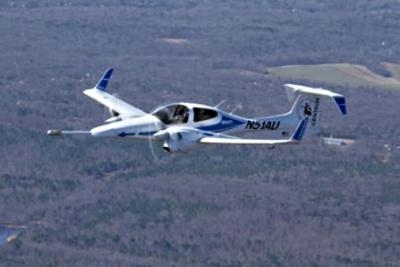Thu, May 30, 2013
Integrated Aboard Centaur Aircraft In Preparation For Arctic Mission
An advanced greenhouse gas measurement system developed by a team comprised of Harvard University's Anderson Research Group, the National Oceanic and Atmospheric Administration (NOAA) Atmospheric Turbulence and Diffusion Division (ATDD), and Aurora Flight Sciences has been integrated aboard Aurora Flight Sciences' Centaur aircraft. The FAA has granted an airworthiness certification for flight operations, and flight tests have already taken place over the Chesapeake Bay.

The new airborne instrument, called FOCAL, was integrated into the Centaur aircraft in preparation for deployment to Alaska later this year.
Global warming has led to thawing of permafrost in the Earth's Arctic regions. As this thawing occurs, buried organic matter and methane hydrates are converted to methane and carbon dioxide gases which permeate upwards through the soil and water and are released into the air. Methane and carbon dioxide are two of the most important greenhouse gases contributing to the warming of the planet.
Harvard and NOAA/ATDD's Flux Observations of Carbon from an Airborne Laboratory (FOCAL) instrument is capable of measuring the fluxes of methane and carbon dioxide, with sufficient precision to distinguish between the thermogenic and biogenic sources of carbon. The FOCAL instrument was developed utilizing recent breakthroughs in lasers, detector technology and ultra-sensitive spectroscopy. The Centaur aircraft permits the FOCAL instrument to measure greenhouse gas emissions over wide ranges of Arctic terrain.
Test flights over the Chesapeake Bay were conducted to calibrate the instrument prior to deployment to the permafrost region of Alaska's Northern Slope later this year. Data products from this research will be provided to the oceanic and atmospheric science communities involved in monitoring rapid environmental changes in the Arctic region. The National Science Foundation (NSF) sponsored this scientific research program.
"Global environmental change represents a major threat to both our national security and our world economy," stated John Langford, Aurora's CEO. "Aurora Flight Sciences was founded to provide UAVs to the science community for global environmental monitoring, and we are thrilled to be working with our original customer, Harvard's Anderson Research Group, on this fundamental research."
(Image of Centaur aircraft fitted with FOCAL instrument provided by Aurora Flight Sciences)
More News
Terminal Radar Service Area Airspace surrounding designated airports wherein ATC provides radar vectoring, sequencing, and separation on a full-time basis for all IFR and participa>[...]
Very High Frequency (VHF) The frequency band between 30 and 300 MHz. Portions of this band, 108 to 118 MHz, are used for certain NAVAIDs; 118 to 136 MHz are used for civil air/grou>[...]
“From approximately November 2021 through January 2022, Britton-Harr, acting on behalf of AeroVanti, entered into lease-purchase agreements for five Piaggio-manufactured airc>[...]
Also: Virtual FLRAA Prototype, IFR-Capable Autonomous A/C, NS-32 Crew, Golden Dome Missile Defense Bombardier announced that the first production Global 8000 successfully completed>[...]
Aero Linx: The 1-26 Association (Schweizer) The Association’s goal is to foster the helpfulness, the camaraderie, and the opportunity for head-to-head competition that is fou>[...]
 ANN's Daily Aero-Term (05.29.25): Terminal Radar Service Area
ANN's Daily Aero-Term (05.29.25): Terminal Radar Service Area ANN's Daily Aero-Term (05.30.25): Very High Frequency (VHF)
ANN's Daily Aero-Term (05.30.25): Very High Frequency (VHF) Aero-News: Quote of the Day (05.30.25)
Aero-News: Quote of the Day (05.30.25) Airborne 05.23.25: Global 8000, Qatar B747 Accepted, Aviation Merit Badge
Airborne 05.23.25: Global 8000, Qatar B747 Accepted, Aviation Merit Badge ANN's Daily Aero-Linx (05.30.25)
ANN's Daily Aero-Linx (05.30.25)



